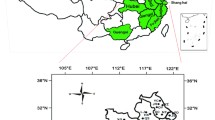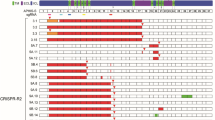Abstract
Development of insecticide resistance in insect populations is a major challenge to sustainable agriculture and food security worldwide. Buprofezin, one of the commonly used chitin synthesis inhibitors, has severely declined its control efficacy against the brown planthopper (BPH, Nilaparvata lugens), a devastating rice insect species. To date, however, mechanism of buprofezin resistance in target pests remains elusive. We conducted a long-term (25 years from 1996 to 2020) and large geographical scale (11 provinces and cities in China) resistance monitoring program for buprofezin in BPH, a notorious pest of rice crop in East and Southeast Asia. BPH rapidly developed resistance with > 1,000-fold resistance being detected in nearly all the field populations after 2015. Using the bulk segregant mapping method, we uncovered a novel mutation (G932C) in chs1 gene encoding chitin synthase 1 from a near isogeneic buprofezin-resistant (> 10,000-fold) strain harboring recessive, monogenic resistance. Using CRISPR/Cas9-based genome-modified Drosophila melanogaster possessing the same mutation as a model, we found that the G932C mutation was not only responsible for buprofezin resistance but also conferred a cross-resistance to cyromazine, an insect molting disruptor, on which the mode of action is largely unknown. Taken together, our study for the first time revealed the molecular mechanism conferring buprofezin resistance in BPH and implicated that cyromazine also targets chitin biosynthesis to confer its toxicity.





Similar content being viewed by others
References
Bel Y, Wiesner P, Kayser H (2000) Candidate target mechanisms of the growth inhibitor cyromazine: Studies of phenylalanine hydroxylase, puparial amino acids, and dihydrofolate reductase in dipteran insects Archives of insect biochemistry and physiology 45:69–78
Binnington K (1985) Ultrastructural changes in the cuticle of the sheep blowfly. Lucilia, Induced by Certain Insecticides and Biological Inhibitors Tissue and Cell 17:131–140
Candy D, Kilby B (1962) Studies on chitin synthesis in the desert locust. J Exp Biol 39:129–140
Chen Z, Robin C, Damiano J et al (2006) Positional cloning of a cyromazine resistance gene in Drosophila melanogaster. Insect Mol Biol 15:181–186. https://doi.org/10.1111/j.1365-2583.2006.00622.x
Chu Y, Clevenger J, Hovav R et al. (2016) Chapter 7 - Application of Genomic, Transcriptomic, and Metabolomic Technologies in Arachis Species. In: Stalker HT, F. Wilson R (eds) Peanuts. AOCS Press, pp 209–240. doi:https://doi.org/10.1016/B978-1-63067-038-2.00007-1
De Cock A, Ishaaya I, Degheele D et al. (1990) Vapor toxicity and concentration-dependent persistence of buprofezin applied to cotton foliage for controlling the sweetpotato whitefly (Homoptera: Aleyrodidae) J Econ Entomol 83:1254–1260
Demaeght P, Ukken, FP, Rubinstein, CD et al. (2014) High resolution genetic mapping uncovers chitin synthase-1 as the target-site ofthe structurally diverse mite growth inhibitors clofentezine, hexythiazox and etoxazole in Tetranychus urticae Insect Biochem Mol Biol 51:52–61
Douris V, Papapostolou, KM, Ilias A et al. (2017) Investigation of the contribution of RyR target-site mutations in diamide resistance by CRISPR/Cas9 genome modification in Drosophila Insect Biochem Mol Biol 87:127–135
Douris V, Steinbach D, Panteleri R et al (2016) Resistance mutation conserved between insects and mites unravels the benzoylurea insecticide mode of action on chitin biosynthesis. Proc Natl Acad Sci U S A 113:14692. https://doi.org/10.1073/pnas.1618258113
El-Oshar M, Motoyama N, Hughes P et al. (1985) Studies on cyromazine in the house fly, Musca domestica (Diptera: Muscidae) J Econ Entomol 78:1203–1207
Fotoukkiaii SM, Wybouw N, Kurlovs AH et al. (2021) High-resolution genetic mapping reveals cis-regulatory and copy number variation in loci associated with cytochrome P450-mediated detoxification in a generalist arthropod pest PLoS genet 17:e1009422
Georghiou GP (1969) Parasitological review. Genetics of Resistance to Insecticides in Houseflies and Mosquitoes Exp Parasitol 26:224–255. https://doi.org/10.1016/0014-4894(69)90116-7
Gokcezade J, Sienski G, Duchek P (2014) Efficient CRISPR/Cas9 Plasmids for Rapid and Versatile Genome Editing in Drosophila G3-Genes Genomes Genetics 4:2279–2282 doi:https://doi.org/10.1534/g3.114.014126
Gratz SJ, Ukken FP, Rubinstein CD et al. (2014) Highly specific and efficient CRISPR/Cas9-catalyzed homology-directed repair in Drosophila Genetics 196:961–971 doi:https://doi.org/10.1534/genetics.113.160713
Khush GS (1999) Green revolution: preparing for the 21st century Genome 42:646–655
Li H, Durbin R (2009) Fast and Accurate Short Read Alignment with Burrows-Wheeler Transform Bioinformatics 25:1754–1760
Ma W et al (2021) Chromosomal-Level Genomes of Three Rice Planthoppers Provide New Insights into Sex Chromosome Evolution Mol Ecol Resour 21:226–237. https://doi.org/10.1111/1755-0998.13242
Merzendorfer H (2006) Insect chitin synthases: a review. J Comp Physiol B Biochem Syst Environ Physiol 176:1–15. https://doi.org/10.1007/s00360-005-0005-3
Michelmore RW, Paran I, Kesseli RV (1991) Identification of markers linked to disease-resistance genes by bulked segregant analysis: a rapid method to detect markers in specific genomic regions by using segregating populations. Proc Natl Acad Sci U S A 88:9828–9832. https://doi.org/10.1073/pnas.88.21.9828
Miller R, Corley C, Cohen C et al. (1981) CGA 19255 and CGA 72662: mode of action and efficacy against flies in the laboratory and when administered to cattle as feed additive Southwest Entomol 6:272–278
Mu XC, Zhang W, Wang LX et al (2016) Resistance monitoring and cross-resistance patterns of three rice planthoppers, Nilaparvata lugens, Sogatella furcifera and Laodelphax striatellus to dinotefuran in China. Pestic Biochem Physiol 134:8–13. https://doi.org/10.1016/j.pestbp.2016.05.004
Pener MP, Dhadialla TS (2012) Chapter One - An Overview of Insect Growth Disruptors; Applied Aspects. In: Dhadialla TS (ed) Advances in Insect Physiology, vol 43. Academic Press, pp 1–162. doi:https://doi.org/10.1016/B978-0-12-391500-9.00001-2
Roditakis E, Steinbach D, Moritz G et al. (2016) Ryanodine receptor point mutations confer diamide insecticide resistance in tomato leafminer, Tuta absoluta (Lepidoptera: Gelechiidae) Insect Biochem Mol Biol 80:11–20
Stone B (1968) A formula for determining degree of dominance in cases of monofactorial inheritance of resistance to chemicals. Bull World Health Organ 38:325
Takagi H, Abe A, Yoshida K et al. (2013) QTL‐seq: rapid mapping of quantitative trait loci in rice by whole genome resequencing of DNA from two bulked populations The Plant Journal 74:174–183
Wang K, Li M, Hakonarson H (2010) ANNOVAR: functional annotation of genetic variants from high-throughput sequencing data Nucleic Acids Res 38:e164-e164
Wang L, Fang J, Liu B (2008a) Relative toxicity of insecticides to Laodelphax striatellus (Fallén)(Homoptera: Delphacidae) and the resistance of field populations from different areas of East China Acta Entomologica Sinica 51:930–937
Wang Y, Chen J, Zhu YC et al. (2008b) Susceptibility to neonicotinoids and risk of resistance development in the brown planthopper, Nilaparvata lugens (Stål)(Homoptera: Delphacidae) Pest Manag Sci 64:1278–1284
Wang Y, Gao C, Xu Z et al. (2008c) Buprofezin susceptibility survey, resistance selection and preliminary determination of the resistance mechanism in Nilaparvata lugens (Homoptera: Delphacidae) Pest Manag Sci 64:1050–1056 doi:https://doi.org/10.1002/ps.1606
Wang Y, Gao C, Zhu Y et al. (2008d) Imidacloprid susceptibility survey and selection risk assessment in field populations of Nilaparvata lugens (Homoptera: Delphacidae) J Econ Entomol 101:515–522
Wu S, Guo C, Zhao H et al. (2019) Drosulfakinin signaling in fruitless circuitry antagonizes P1 neurons to regulate sexual arousal in Drosophila Nat Commun 10:4770 doi:https://doi.org/10.1038/s41467-019-12758-6
Wu S, Zeng B, Zheng C et al. (2018) The evolution of insecticide resistance in the brown planthopper (Nilaparvata lugens Stål) of China in the period 2012–2016 Sci Rep 8:4586 doi:https://doi.org/10.1038/s41598-018-22906-5
Zhu KY, Merzendorfer H, Zhang W, e al. (2016) Biosynthesis, Turnover, and Functions of Chitin in Insects. Annu Rev Entomol 61:177–196
Acknowledgements
This research was supported by the National Natural Science Foundation of China (No. 31972298 & 32022011) and the Jiangsu Agriculture Science and Technology Innovation Fund (CX [19]3003). We thank Plant Protection Stations of Shanghai City, Jiangsu Province, Anhui Province, Zhejiang Province, Hubei Province, Jiangxi Province, Fujian Province, Guangdong Province, Guangxi Province and Hainan Province for helping in collecting tested populations of N. lugens
Author information
Authors and Affiliations
Corresponding author
Ethics declarations
Conflict of interests
The authors have no competing interest in this work.
Ethical approval
This article does not contain any studies with human participants or animals performed by any of the authors.
Additional information
Communicated by Emmanouil Roditakis .
Publisher's Note
Springer Nature remains neutral with regard to jurisdictional claims in published maps and institutional affiliations.
Supplementary Information
Below is the link to the electronic supplementary material.
Rights and permissions
About this article
Cite this article
Zeng, B., Chen, FR., Liu, YT. et al. A chitin synthase mutation confers widespread resistance to buprofezin, a chitin synthesis inhibitor, in the brown planthopper, Nilaparvata lugens. J Pest Sci 96, 819–832 (2023). https://doi.org/10.1007/s10340-022-01538-9
Received:
Revised:
Accepted:
Published:
Issue Date:
DOI: https://doi.org/10.1007/s10340-022-01538-9




